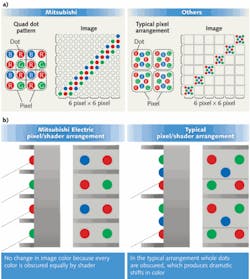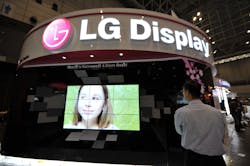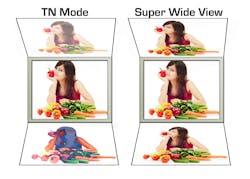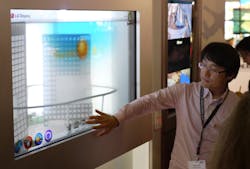PHOTONICS APPLIED: DISPLAYS: Digital signage: What will they think of next?

According to LG Display (Seoul, Korea), digital signage—which encompasses any electronic display that seeks to advertise or convey information—has the largest growth potential in the display industry, because many other information technology (IT) and television (TV) display sectors have reached maturity.1 LG and other display manufacturers are introducing—almost daily, it seems—new digital signage technologies that offer either a bigger and better viewing experience, or novel functionality that is both “surprising” and eye-catching for the consumer.
Bigger and better
At Super Bowl XLV at Cowboys Stadium in Dallas, TX, football fans were probably wowed by what was then the world’s largest high-definition television (HDTV) video screen. Mitsubishi Electric’s (Tokyo, Japan) 160 ft long, 72 ft tall, 600 ton wonder uses 10.5 million light-emitting diodes (LEDs) to create a very bright, incredibly large viewing experience. Installed in 2009, the Diamond Vision LED screen uses unique “Quad Dot Pattern” technology and eliminates color shift through a pixel/shader arrangement for each color LED rather than for a group of LEDs (see Fig. 1). But believe it or not, May 2011 is the expected debut of the even bigger 200 ft long, 80 ft tall HDTV screen at the Charlotte Motor Speedway (Charlotte, NC). Built by Panasonic (Osaka, Japan), the display will incorporate 9 million LEDs.
Unlike these ultralarge LED-based stadium or skyscraper displays that can consist of one-square-foot tiles assembled into larger 6 × 8 ft sections that are then grouped together, more moderate advertising-oriented displays are typically thin-film-transistor liquid-crystal display (TFT LCD), plasma, or organic LED (OLED) varieties. The largest flat-panel display glass substrates manufactured today—Gen 10 or generation 10 glass—top out at nearly 9 × 10 ft, so these moderate-sized consumer displays are typically manufactured at some fraction of this maximum (such as 15 individual 42 in. displays in one Gen 10 panel), with the largest continuous or single-glass display—at 108 in. on the diagonal—manufactured by Sharp (Osaka, Japan).
To increase the display size beyond these glass-constrained maximums, however, display providers can stitch together several smaller displays to create a larger one. For an improved viewing experience for these “stitched” displays, manufacturers continue to reduce the “bezel” or separation border between display units. In March 2011, LG Display announced a prototype of the narrowest-bezel display in the industry, with a maximum 4 mm bezel separating individual displays (1.5 mm at left/right and 2.5 mm at top/bottom) to create a single 111 in. display from nine 37 in. displays (see Fig. 2).Digital signage often occupies an outdoor rather than an indoor space, so manufacturers are working to improve current display technologies for better viewing in a variety of environmental conditions. Most LCD screens, for example, begin to turn black at surface temperatures above 75ºC—not difficult to reach considering that 30°C (86°F) air temperatures can quickly create 85°C display surface temperatures. Just as water has a boiling point and a freezing point, liquid crystals cannot operate optimally above or below certain temperatures when the liquid crystal converts from its nematic, functional state, to its non-functional isotropic state. But LG Display has developed a proprietary high-brightness (2000 cd/m2) LCD screen that eliminates blackening for surface temperatures between -30°C (-22°F) and +110°C (+230°F), allowing these panels to be used as outdoor displays without requiring cooling or additional electricity.
Optrex America (Plymouth, MI) is improving the viewing experience with its “wide-angle-viewing” capability that improves over traditional twisted-nematic (TN) LCDs. “In the traditional TN type of display, colors will shift when viewed from an off-perpendicular angle,” says Jessica He, marketing manager at Optrex America. “When displaying advertisements via digital signage, the display needs to deliver the image’s true color: The red must be red, not pinkish red; and the blue must be blue, not greenish blue. This is critical for advertising, as the true colors must be conveyed to effectively promote the merchandise.” The Optrex Super Wide View (SWV) technology solves this color-shift issue by reducing the amount of light scattering in the LCD matrix through, among other improvements, horizontal alignment of the liquid crystal cells such that the crystal molecules move parallel to the panel plane rather than perpendicular to it. The result is a wide viewing angle greater than 170° and accurate color viewing from any direction (see Fig. 3).New gimmicks
Advertisers want to grab the viewer’s attention. Imagine walking by an ordinary see-through window display and noticing small, brightly colored visual display objects seemingly “embedded” into the screen that enhance the content behind the window. The new “window display” from LG Display does precisely this. Composed of standard TFT LCD materials, the transparency of the display is achieved through edge-lit LED illumination (LEDs are hidden in the bezel of the display) and optimization of the display’s polarization layers (see Fig. 4).LG Display has also announced a complementary “mirror display” that adds thin, multilayer mirror films on the display’s polarizer layer. These coatings give the display the appearance of a mirror when the backlight is off. But when the backlight is on, the screen reverts to a full display and the thin mirror-like film coating is not noticeable to the observer.
Beyond conventional flat panels, many companies are delivering flexible displays to add a new dimension to digital signage. NanoLumens (Norcross, GA) has developed a 112 in., 80 lb, $75,000 digital display that can be wrapped around columns or placed on curved surfaces. And Universal Display Corp. (Ewing, NJ) has even delivered wrist-mounted phosphorescent OLED displays built on thin, flexible metal foil to the US Army. These displays offer the ultimate in digital signage: “communications” devices that can display real-time unmanned aerial vehicle (UAV) video feeds and other battlefield images received through computers running different applications.
And of course, there are numerous three-dimensional (3D) technologies on the market. Toshiba (Tokyo, Japan) debuted a new 2D/3D LED wall display viewable in conventional 2D or passive, glasses-based 3D.2 Developed in conjunction with Chroma3D Systems (Cannon Falls, MN), the new display has red, green, blue (RGB), and yellow (Y) pixels. The 2D image uses the conventional RGB pixels, but depth information uses the Y pixels. For stereoscopic 3D viewing, one lens in the passive glasses transmits restricted portions of the red, green, and blue spectrum and the other lens transmits only yellow.
And just when you thought flexible displays and 3D capability might be the advertiser’s ultimate digital signage gimmicks to enhance the consumer experience, many new technologies are trading a “passive” onlooker approach for an “active” one. Advertisers are hoping that gesture recognition will attract consumers as it has gamers—actively engaging them in the buying process. You’ve already seen how projection touch screens could be used to order menu items in a restaurant, but how about a screen that doesn’t require you to actually touch it? With gesture recognition from Crunchfish AB (Malmö, Sweden), a user can click, drag, drop, and scroll with simple finger movements in front of a camera, allowing the viewer to control graphical objects in three dimensions. “But why limit movements to the finger? Imagine a camera being able to interpret your facial expression when an advertisement pops up on your screen,” says Thomas Gårdängen, CTO and co-founder of Crunchfish AB. “A prototype has been showcased in Crunchfish’s research lab that currently works on any C-based software platform using the existing laptop camera. The next step is to system test the gesture control capability with our existing 3D rendering engine for cell phones. The technology tracks very well under extreme low-light conditions and also learns to interact with different users.”
An interactive future
A Wall Street Journal supplement article on the future of digital signage begins by describing how coffee-shop patrons in Israel, while ordering a coffee, responded to a small digital sign flashing next to the cash register advertising a line of healthy sandwiches.3 The customers responded to the prompt on the screen and ordered. The cashier didn’t need to participate in the sales process by remembering to ask whether the patrons would like a sandwich; the order was adjusted on the fly without holding up the line, and the price was immediately added to the total sale—an excellent example of future digital signage or digital place-based media (DPBM), as it is being called.
Long gone are the days of “bulky CRT monitors and one-way delivery of repurposed TV content” says the article, thanks to the multisized, thinner, cheaper, and brighter display technologies that can change content on the fly and be programmed to communicate with external devices. But despite the $1.4 billion that retailers spent to market products on digital screens in 2009, the article says that digital signage is still limited by the overwhelming and fragmented array of digital signage offerings. The market also lacks standardization in terms of how the digital message is displayed and how the network controlling it is maintained, a trained workforce in the event of technical problems with the displays or network, and available metrics returned from the display medium that allow advertisers to know how long an individual was engaged with the message and how they ultimately responded.
And yet progress is being made. Intel (Santa Clara, CA) has demonstrated a proof-of-concept interactive digital signage system using an Intel processor and a Microsoft Windows 7 operating system with multi-user, multitouch holographic display technology and metrics capability that allow in-store customers to explore merchandise, submit feedback on products, and even share social networking reviews. Personally, I find the bombardment of digital media to be annoying after spending most of my day on the computer. But look out!—digital signage is coming to a store, a stadium, or even a coffee shop near you.
REFERENCES
2. http://displaydaily.com/2011/02/18/simultaneous-2d-and-3d-viewing-cool/
3. J. Avalos, “The Future of Digital Signage: Integrated, Interactive, Intelligent Networks,” Wall Street Journal MEDIAPLANET supplement, 3, 1 (April 2010).

Gail Overton | Senior Editor (2004-2020)
Gail has more than 30 years of engineering, marketing, product management, and editorial experience in the photonics and optical communications industry. Before joining the staff at Laser Focus World in 2004, she held many product management and product marketing roles in the fiber-optics industry, most notably at Hughes (El Segundo, CA), GTE Labs (Waltham, MA), Corning (Corning, NY), Photon Kinetics (Beaverton, OR), and Newport Corporation (Irvine, CA). During her marketing career, Gail published articles in WDM Solutions and Sensors magazine and traveled internationally to conduct product and sales training. Gail received her BS degree in physics, with an emphasis in optics, from San Diego State University in San Diego, CA in May 1986.


